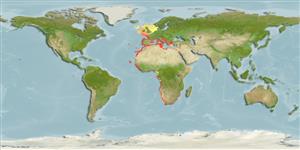Classification / Names
Common names from other countries
Main reference
Size / Weight / Age
Max length : 50.0 cm TL male/unsexed; (Ref. 4510); common length : 30.0 cm TL male/unsexed; (Ref. 2683); max. published weight: 3.0 kg (Ref. 40637)
Environment
Marine; brackish; demersal; non-migratory; depth range 20 - 500 m (Ref. 4510), usually ? - 150 m (Ref. 27000)
Climate / Range
Subtropical, preferred 25°C (Ref. 107945); 60°N - 35°S, 26°W - 36°E
Distribution
Eastern Atlantic: British Isles (rare) to Senegal including Madeira, the Canary Islands, and Cape Verde. Also throughout the Mediterranean except Black Sea. South African species thought to be the same as population in the northeast Atlantic (Ref. 4313).
Countries | FAO areas | Ecosystems | Occurrences | Introductions
Short description
IUCN Red List Status (Ref. 115185)
Human uses
Fisheries: commercial; aquarium: public aquariums
More information
Common namesSynonymsMetabolismPredatorsEcotoxicologyReproductionMaturitySpawningFecundityEggsEgg development
ReferencesAquacultureAquaculture profileStrainsGeneticsAllele frequenciesHeritabilityDiseasesProcessingMass conversion
Tools
Special reports
Download XML
Internet sources
Estimates of some properties based on models
Phylogenetic diversity index
PD50 = 0.5000 many relatives (e.g. carps) 0.5 - 2.0 few relatives (e.g. lungfishes)
Trophic Level
4.3 ±0.5 se; Based on diet studies.
Resilience
Low, minimum population doubling time 4.5 - 14 years (K=0.08)
Vulnerability
High to very high vulnerability (68 of 100)
Price category
